In nature, everything is connected! Plants and animals are connected in lots of different ways, and every species in the food web is important.
The bottom of the marine food chain typically starts with energy and tiny living things called phytoplankton. Found near the water’s surface, they take in the sun’s light and turn it into energy through a process called photosynthesis. The next level is made up of plant-eaters, followed by small carnivores (such as small fish), followed by top predators (such as sharks, tuna and dolphins).
JARGON BUSTER! Plankton is the name given to a collection of tiny organisms that float around in aquatic environments. Plankton that is made up of plants is called PHYTOPLANKTON. Plankton that is made up of tiny animals is called zooplankton.
JARGON BUSTER! Photosynthesis is the process in which plants use sunlight to make their own food. Plants have something called chlorophyll (that makes them green!) that absorbs sunlight and produces energy, releasing oxygen. Photosynthesis is very important because almost all living things depend on plants for food!

This activity will help a group to think about which animal and plant species are connected by creating their own food web.
What you will need:
- This game requires a minimum of ten young people.
- An open space (this could be by the coast, a grassy area in your local park, or an indoor space)
- Ball of string/twine
- Printable instruction sheet (can be digital or paper copy)
How to play:
You can download and print the instruction sheet below.
- First, ask the children these questions to help get them thinking about where food comes from:
- Where do we get our energy from? Answer: the plants and animals we eat
- Where do animals get their energy from? Answer: the plants and animals they eat
- Where do plants get their energy from? Answer: the sun
- Have your group create a circle shape. Give each young person a marine species from the list. All 10 should be included. If you have more than 10 young people, have extra of some species.
- They can warm up by acting like that plant or animal – what does it look like? How does it move? Does it make any noise?
- It’s time to start thinking about who relies on who! Pass the ball of twine to the orca. The orca should keep hold of the end of the string and then pass the ball of string to anyone it eats, i.e. anyone who is a seal, squid, small fish or a seabird! Does anything eat the orca?
- Whoever now has the ball of string should think about what they eat, and what eats them! Holding onto their end, they should pass the ball of string to those species.
- This repeats until everybody is connected by the string or until you have gone through every species. It can continue until species have many connections and hands full of string!
- Once the food web is complete, ask your group what they think would happen if you remove a species? All life on earth relies on the sun! If there was no sunlight, we would have no plankton and algae. Anyone who is plankton or algae, ask them to release/drop the string they are holding. Next, those who eat plankton and algae should then be removed, followed by those who eat those now removed animals. What is happening to the food web? It’s collapsing because everything is connected!
Species list
| Species | What they need/eat |
| Plankton | Sunlight |
| Algae (seaweed) | Sunlight |
| Crab | Algae |
| Krill (small shrimps) | Plankton, algae |
| Small fish | Plankton |
| Squid | Crab, small fish, krill |
| Seabird | Small fish, crab, |
| Seal | Small fish, squid, seabirds |
| Dolphin | Small fish, squid, plankton, krill |
| Orca (killer whale) | Seals, squid, small fish, seabirds, and other dolphin |
This activity was developed for the Royal Scottish National Orchestra
to accompany their early years animated film, Yoyo & the Little Auk.
